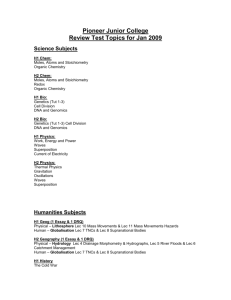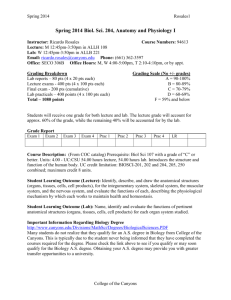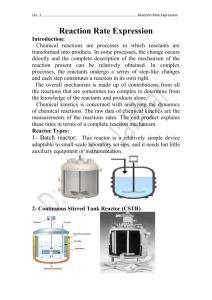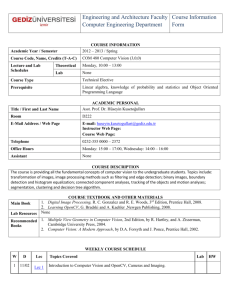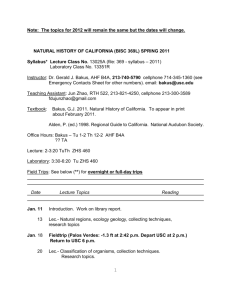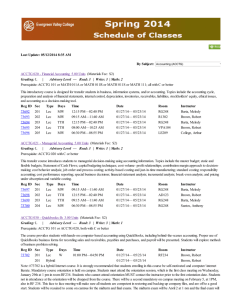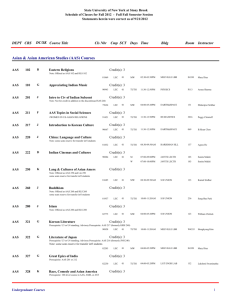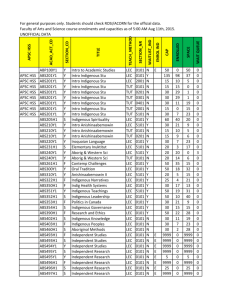Bio 155 - Natural History of Animals Dr. Beverly Krilowicz
advertisement
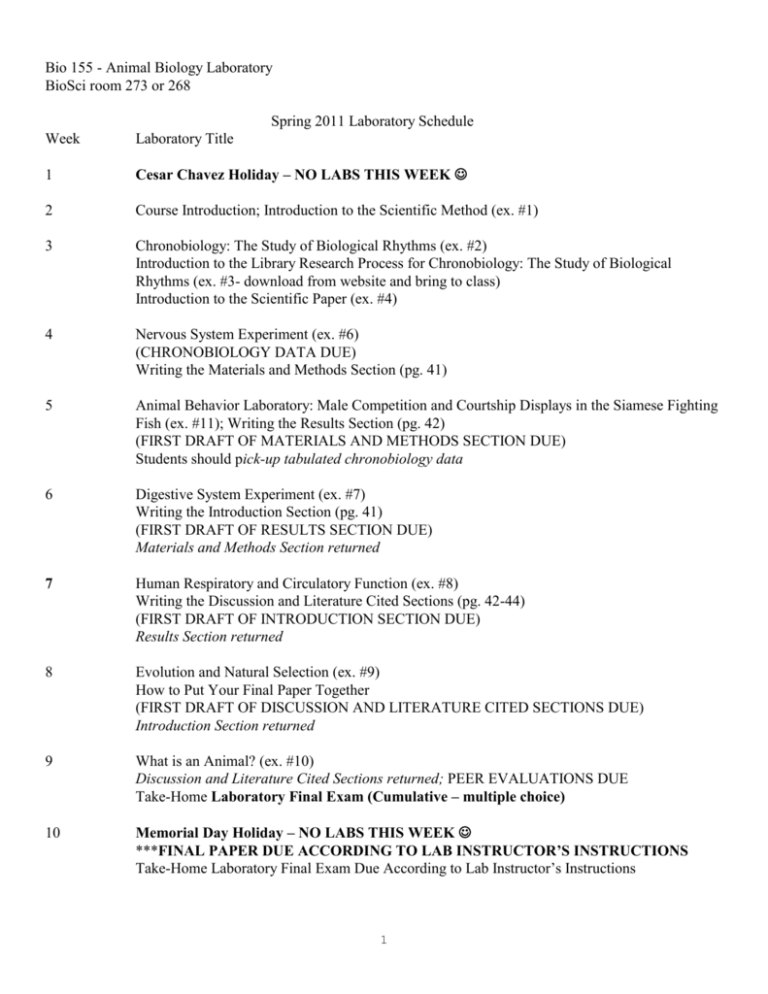
Bio 155 - Animal Biology Laboratory BioSci room 273 or 268 Spring 2011 Laboratory Schedule Week Laboratory Title 1 Cesar Chavez Holiday – NO LABS THIS WEEK 2 Course Introduction; Introduction to the Scientific Method (ex. #1) 3 Chronobiology: The Study of Biological Rhythms (ex. #2) Introduction to the Library Research Process for Chronobiology: The Study of Biological Rhythms (ex. #3- download from website and bring to class) Introduction to the Scientific Paper (ex. #4) 4 Nervous System Experiment (ex. #6) (CHRONOBIOLOGY DATA DUE) Writing the Materials and Methods Section (pg. 41) 5 Animal Behavior Laboratory: Male Competition and Courtship Displays in the Siamese Fighting Fish (ex. #11); Writing the Results Section (pg. 42) (FIRST DRAFT OF MATERIALS AND METHODS SECTION DUE) Students should pick-up tabulated chronobiology data 6 Digestive System Experiment (ex. #7) Writing the Introduction Section (pg. 41) (FIRST DRAFT OF RESULTS SECTION DUE) Materials and Methods Section returned 7 Human Respiratory and Circulatory Function (ex. #8) Writing the Discussion and Literature Cited Sections (pg. 42-44) (FIRST DRAFT OF INTRODUCTION SECTION DUE) Results Section returned 8 Evolution and Natural Selection (ex. #9) How to Put Your Final Paper Together (FIRST DRAFT OF DISCUSSION AND LITERATURE CITED SECTIONS DUE) Introduction Section returned 9 What is an Animal? (ex. #10) Discussion and Literature Cited Sections returned; PEER EVALUATIONS DUE Take-Home Laboratory Final Exam (Cumulative – multiple choice) 10 Memorial Day Holiday – NO LABS THIS WEEK ***FINAL PAPER DUE ACCORDING TO LAB INSTRUCTOR’S INSTRUCTIONS Take-Home Laboratory Final Exam Due According to Lab Instructor’s Instructions 1 Required laboratory textbooks: Laboratory Exercises in Animal Biology, Krilowicz and Henter, 1999 revision It will be the responsibility of the student to download and print certain laboratory materials posted to the course website at http://instructional1.calstatela.edu/rstewar/ under Biology 155 on the Course List. Late Work Policy: Late drafts or papers will have 10% (one grade) deducted per day, including weekends. All assignments are due at the beginning of the regularly scheduled laboratory period. The deadline for submission of your final paper is 24 hours prior to your final lecture examination. This deadline provides the laboratory instructors with adequate time to assess and return your paper to you at the final exam. Late penalties still apply. Laboratory Exercises: Laboratory exercises will be turned in at the end of the laboratory period. Laboratory Quizzes: Five pop quizzes worth 10 points each will be given during the quarter. The dates and times of these quizzes are at the discretion of the individual instructors. The lowest quiz score will be dropped. Peer Evaluations: The other group members will evaluate your work in your laboratory group. Forms with peer evaluation criteria will be supplied early in the quarter so that all group members are aware of these criteria. Each group member will evaluate all other team members. The mean of the scores submitted by your peers will be used in determination of your grade. Final Paper and Drafts: All drafts and the final paper must be typed or produced with a word processing program. Individual instructors may accept drafts and papers submitted as attachments to email messages. Final Laboratory Exam: This is a 50 question, multiple-choice style exam, based on the exercises you complete in lab during the term. You will need a scantron (#882E) for this exam. Policy Regarding Correction of Errors in Grading of Laboratory Assignments: All errors in the grading of any laboratory assignments must be reported to the laboratory instructor of record by Friday of tenth week of the quarter. The only exceptions to this policy are assignments due at the 10th week laboratory meeting. Concerns about grading of these assignments must be reported and discussed with the laboratory instructor of record at the final examination. Academic Honesty Policy: Students are expected to read and abide by the University's Academic Honesty Policy, which can be found at http://www.calstatela.edu/academic/senate/handbook/ch5a.htm Students who violate this policy will be subject to disciplinary action, and may receive a failing grade in the course for a single violation Grading: 160 pts. 8 laboratory exercises @ 20 pts./exercise 40 pts. 4 laboratory quizzes @ 10 pts./quiz 50 pts. Mean of peer evaluations 10 pts. Chronobiology Data 10 pts. Introduction, draft 10 pts. Materials and Methods, draft 10 pts. Results, draft 10 pts. Discussion and Literature Cited, draft 100 pts. Final Paper 50pts Take-Home Laboratory Final Exam (Scantron) 2 450 pts. Total Course Objectives: 1) The student will demonstrate an understanding of and be able to apply the steps in the scientific method while conducting an experiment. (Lec. #2, Lab Ex. #1-2,7 and 11) 2) The student will demonstrate an understanding of the differences between Biology and the other natural sciences and will be able to give a definition of a living organism. (Lec. #1) 3) The student will demonstrate an understanding of the hierarchical nature of animal bodies and will be able to a) define, identify and give functions for the major cellular organelles. (Lec. #3, Lab ex. #5) b) give a definition of a cell. (Lec #3, Lab ex. #5) c) define, identify and give functions for the major animal tissues. (Lec. #4, Lab ex. #5) d) identify the tissues found in major organs. (Lab ex. #5) e) define, identify and give functions for the major organ systems found in animals. (Lec. #4-13, Lab ex. #5-8) 4) The student will be able to define homeostasis and give examples of negative feedback loops operative in animals. (Lec. #4-7, Lab ex. #2,6,8) 5) The student will demonstrate an understanding of the basic structure and function of representative organ systems found in animals. (Lec. #5-13, Lab ex. #6-8) 6) The student will demonstrate a knowledge of the great diversity and adaptation in design of these systems across the animal kingdom. (Lec. #5-13, Lab ex. #6-8) 7) The student will demonstrate an understanding of the basic steps in animal development, including gamete formation using meiosis. (Lec. #14) 8) The student will demonstrate an understanding of the basic concepts of genetic inheritance including the structure and function of DNA, RNA and proteins. (Lec. #15) 9) The student will demonstrate an understanding of the basic concepts of evolution including a) the concept of natural selection. (Lec. #15, Lab ex. #9) b) the definition of a species. (Lec. #16, Lab ex. #9) c) evidence for natural selection and evolution. (Lec. #15-16, Lab ex. #9) 10) The student will demonstrate an understanding of the great diversity within the animal kingdom, particularly within the context of evolution. (Lec. #16, Lab ex. #10) 11) The student will demonstrate an understanding of the genetic and environmental basis of animal behavior and give examples of a variety of different types of behaviors. (Lec. #8, Lab ex. #2,11) 12) The student will demonstrate knowledge of the conventions of scientific writing by preparing a report of the findings from the experiment conducted in 1) above. (Lab ex. #4, Lab weeks 2-10) 13) The student will demonstrate an understanding of how to use library reference materials in scientific writing. (Lab ex. #3, Lab weeks 2-10) 3
